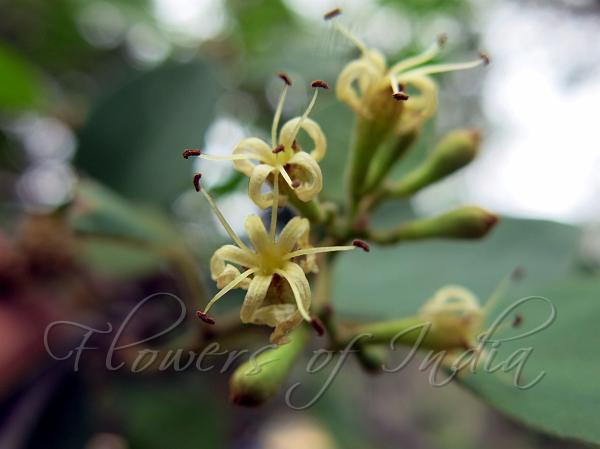|
| Clammy Cherry |
|

|

| File size | 361502 |
| Original date | 6/19/17 10:42 AM |
| Resolution | 2048 x 1536 |
| Flash | Flash did not fire, auto |
| Focal length | 7.513mm |
| Exposure time | 1/640s |
| Aperture | 2.8 |
| Focus Distance | |
| Metering Mode | Multi-segment |
| Camera make | Canon |
| Camera model | Canon PowerShot G15 |
| Sensor type | OneChipColorArea |
|
|
|
|
Photo: |
Botanical name: Cordia obliqua Family: Boraginaceae (Forget-me-not family)
Synonyms: Cordia grandis, Cordia myxa, Cordia tremula
Synonyms: Cordia grandis, Cordia myxa, Cordia tremula
Clammy Cherry is a medium sized deciduous tree, about
10 m high, the girth of trunk of a full bearing tree being 75.5 cm,
branchlets hairless, wood soft, light grey, no heartwood. Leaves are
alternate, entire to slightly toothed and hairless, but may be more or
less rough when full grown, variable in shape, from
elliptic-lanceshaped to broad ovate, often with a rounded or
heart-shaped base, basal nerves 3, rarely 5, blade 6-19 x 4-11 cm,
leaf-stalks 2.5-5 cm long. Flowers are bisexual, complete,
short-stalked, actinomorphic, white and hairless. A fully open flower
is 6 mm across on the average. The calyx is cup-shaped. Sepals are
about 4mm in length, slightly toothed from top, light green in color
and gamoseplous. The flower has four creamish white color petals which
are 6mm in length and polypetlous. The androecium contains two stamens,
each having a very small filament and epipetalous. The inflorescence is
at branch-ends or an in leaf-axils cyme, which almost resembling to a
biparous cyme. It has 14 flowers per cluster. Fruit is a drupe, 1.3-2.5
cm long, when ripe yellowish brown, pink or nearly black, shinning but
minutely rugose, endocarp rugose, very hard, in a sweetish sticky,
almost transparent pulp. Clammy Cherry is widely distributed nearly the
whole of the warmer parts of India and Ceylon. Also found in other
parts of the world like Philippines, New Guinea, Hainan, Formosa, Java
and Tropical Australia. Flowering: March-August.
| Identification credit: Saneesh C.S. | Photographed in Horsley Hills, Chittoor, Andhra Pradesh. |
• Is this flower misidentified? If yes,